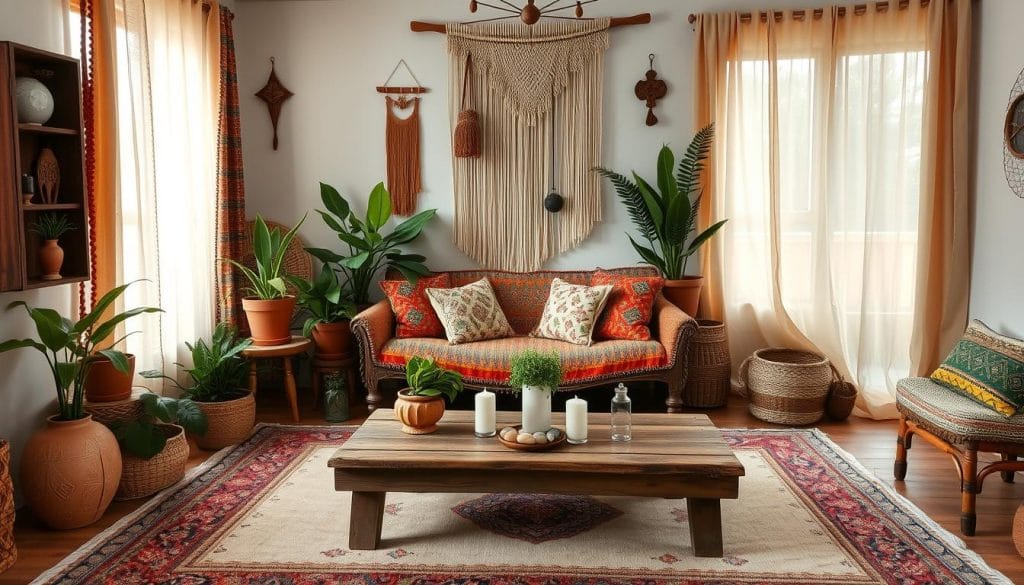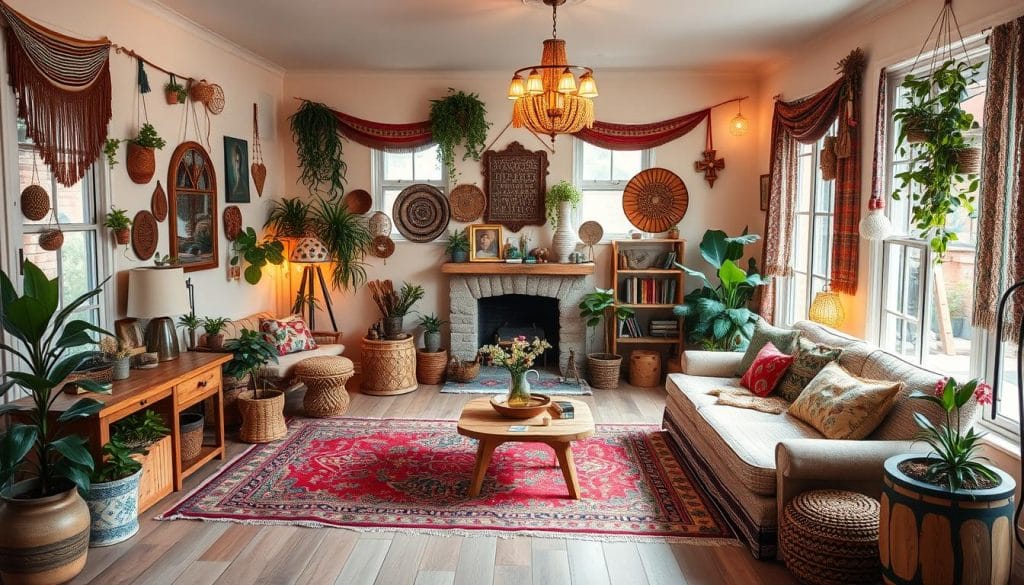Ever walked into a room that felt too perfect? Like you were afraid to sit down or leave a water ring on the table? We’ve all been there. That’s why we’re so excited to share a fresh take on living spaces that’s sweeping homes across the country—a style that hugs you hello instead of giving you the cold shoulder.
Imagine coming home to a place that breathes calm but still feels unapologetically yours. This approach blends clean lines with soul-soothing textures—think linen throw blankets, worn-in wood accents, and that one quirky vase from your favorite trip. It’s not about stripping away personality, but curating it thoughtfully.
We’ll show you how to create rooms that whisper “relax” while shouting “style” in the gentlest way possible. You’ll learn why natural materials like raw clay and undyed wool are secret weapons for cozy-chic spaces. And how strategic pops of color can make your heart skip a beat without overwhelming your senses.
The magic lies in balance. Too sparse feels sterile. Too cluttered creates chaos. But when you nail that sweet spot? That’s where life happens best—mornings with coffee cups leaving happy rings on the table, evenings where the sofa begs you to stay a little longer.
Introduction to Warm Minimalism
We’ve all seen those magazine-perfect rooms that look frozen in time. Now imagine spaces that welcome real living – where your dog’s favorite chew toy and grandma’s handmade quilt earn their place in the layout. This fresh perspective celebrates the art of living comfortably inside simplicity.
https://www.youtube.com/watch?v=yiaOjHS9PDg
When Clean Lines Meet Human Touch
Traditional minimalism sometimes forgot that humans crave connection. The new approach? Keep the clean foundation but add soulful layers. Think of that slightly imperfect ceramic bowl you can’t throw away – it becomes the hero piece on your bare countertop.
From Gallery Walls to Heartfelt Walls
Designers noticed a pattern: people loved airy spaces but hated feeling like visitors in their own homes. The solution? Swap marble floors for oak planks. Replace chrome chairs with linen-swathed seating. Suddenly, your space gains character without losing its crisp structure.
This isn’t just about looks. It’s about creating rooms that hug you when you walk in. Where every chosen object tells a quiet story, and empty surfaces promise calm. Here, less doesn’t mean lack – it means room for life’s beautiful messes.
Understanding the Core Principles of Warm Minimalism Design
Have you ever felt a room was almost right but missing that lived-in charm? That’s where these principles shine. They’re not rules—they’re invitations to craft spaces that feel alive, not empty. Architect Alex Sheft nails it:
“The real discipline is to build just enough, so the space holds its own even when it’s full of life. We’re not interested in blankness. We’re interested in clarity.”
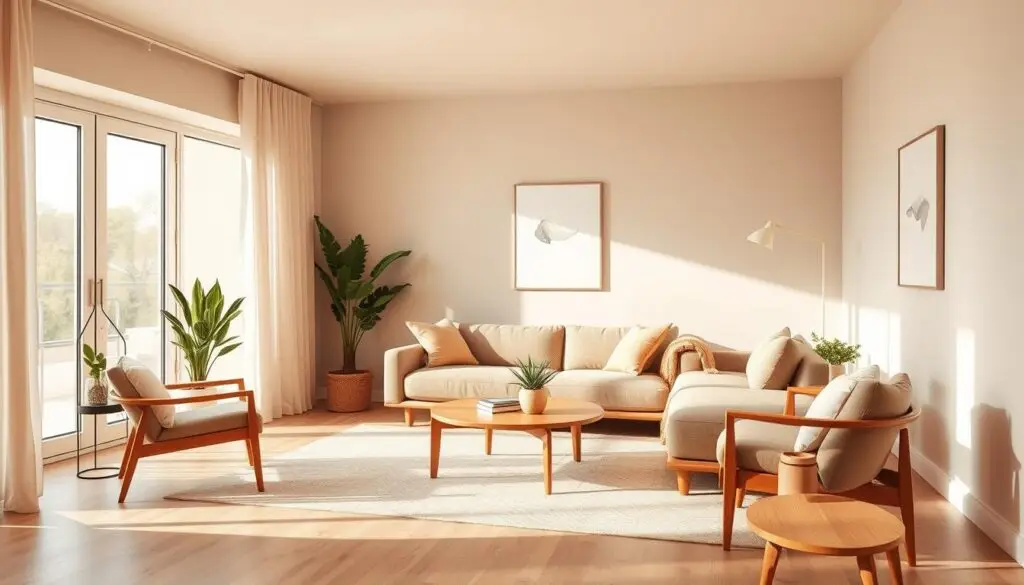
Minimalist Aesthetic with a Touch of Warmth
True simplicity isn’t about subtraction. It’s curation. Think of your room as a gallery—each piece should earn its spot. A single wooden bowl holding lemons. A chunky knit throw casually draped. These intentional elements create pockets of comfort without clutter.
Infusing Personality Through Story-Driven Decor
Your home should whisper who you are, not shout it. Try this: Pick three objects that spark real joy. Place them on a dedicated shelf or console table. Suddenly, that corner becomes a conversation starter. We’ve seen clients use everything from toddler’s first painting to vintage keys from Paris—each tells a tale while keeping the overall look crisp.
This approach works like your favorite playlist. The best tracks flow together, leaving room to breathe between notes. Your space? Same deal. When every shelf, wall, or tray holds meaning without crowding, you get rhythm, not noise. And that’s where life happens best—in spaces that feel designed to be lived in, not just looked at.
Embracing Natural Materials and Wood Accents
What if your floors could tell stories? We’ve seen how natural materials breathe life into rooms that once felt impersonal. Take that reclaimed oak console table with its weathered knots – it’s not just furniture, it’s a conversation starter.

The Quiet Power of Wood
Wood does more than anchor a room – it connects. In a recent project, salvaged cedar ceiling beams transformed a stark white kitchen into a space that hums with earthy charm. Lighter tones like ash or birch work magic in small rooms, while walnut dining tables add depth without heaviness.
Conscious Choices, Lasting Impact
True beauty lies in thoughtful choices. We guide clients toward FSC-certified suppliers and local mills. That barn door made from 100-year-old pine? It reduces waste while adding texture you can’t fake. For fresh inspiration, explore these organic modern living room ideas that pair sustainability with style.
Remember: Grain patterns are nature’s fingerprints. Let them shine through matte finishes rather than high-gloss coatings. A single live-edge shelf becomes art when styled with trailing plants and handmade pottery. This isn’t just design – it’s creating spaces that age gracefully with you.
Balancing Clean Lines and Cozy Textures
Have you ever noticed how the best rooms feel both crisp and comforting? That’s the magic of pairing sharp edges with soft touches. The goal isn’t to erase personality but to let each piece shine through thoughtful contrast.
Layering Light and Texture for Depth
Start with your foundation: keep clean lines in furniture shapes and architectural details. Then, add dimension. Drape a chunky wool throw over a streamlined sofa. Pair a polished concrete side table with a rough-edged ceramic lamp. These combinations create rhythm without chaos.
Lighting plays matchmaker here. Morning sun highlights a linen curtain’s weave, while evening lamps cast shadows on a rattan chair’s pattern. We love using pendant lights with natural materials—think paper shades or hammered metal—to add softness above angular dining tables.
Scale matters too. Large elements like jute rugs ground the room, while smaller accents—woven trays, ribbed vases—add intrigue. Try grouping three textural objects in varying heights: a tall basket, mid-sized stone bowl, and low stack of art books. Suddenly, your shelf tells a tactile story.
Remember: every texture should have breathing room. Leave empty surfaces between layered pieces. This balance lets your eye rest while keeping the space inviting. After all, the best rooms aren’t just seen—they’re felt.
Integrating Warm Neutrals with Bold Accents
Color whispers before it speaks. Where stark whites once dominated, we’re now seeing spaces wrapped in hushed tones that feel like a deep breath. The trick? Building a foundation that calms the eye while leaving room for sparks of personality.
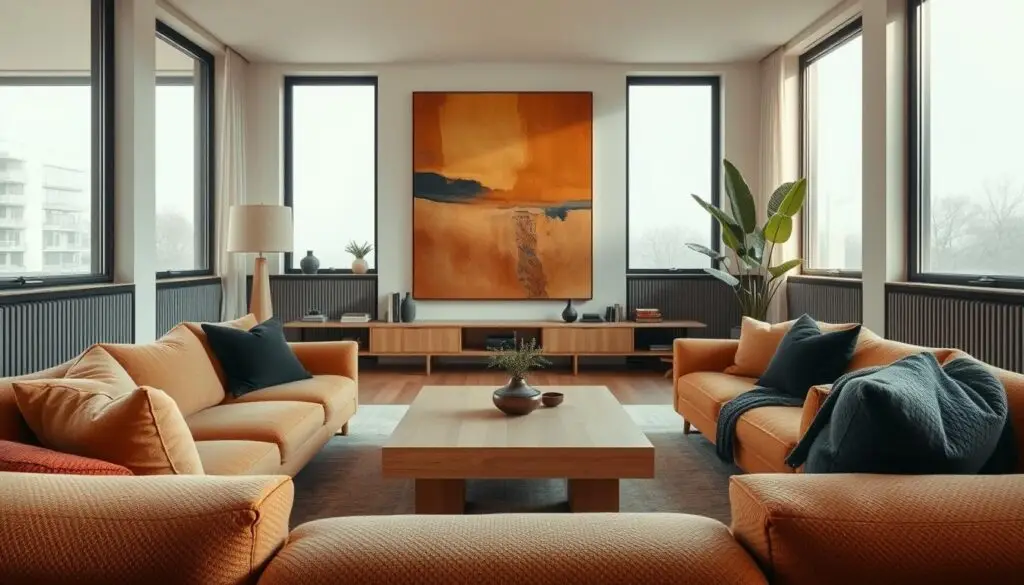
Selecting a Soft Color Palette and Earthy Tones
Start with your walls—they’re the quiet heroes. Swap clinical whites for creamy oat milk or sun-baked clay hues. These tones act like a soft hug for your interior, creating instant warmth without visual noise. We’ve seen clients fall back in love with rooms simply by changing wall colors to muted sage or mushroom gray.
Earth-inspired palettes work magic. Layer terracotta vases against linen sofas, or drape a caramel-hued throw over clean-lined furniture. These choices ground your look while keeping that airy sense of openness. Pro tip: Sample paint at different times of day—what reads as beige at noon might glow peach at sunset.
When you’re ready for drama, add bold accents mindfully. A single emerald-green armchair or navy abstract painting creates focal points that dance against your neutral backdrop. Remember: restraint lets these moments shine. As designer Mara Brent notes,
“The most memorable rooms play peekaboo with color—they tease rather than shout.”
Need ideas? Try a clay-red console table against pale plaster walls, or cluster burnt-orange pillows on a neutral sofa. These touches transform spaces from sterile to soulful, proving that quiet backdrops make the best stages for life’s colorful moments.
Creating Stages for Personal Expression in Minimalist Spaces
What if your walls could whisper stories? Sheft Farrace’s work with Yves Saint Laurent’s Paris apartment reveals the power of intentional staging—where architecture becomes a quiet canvas for meaningful objects. The secret? Treat your room like a gallery curator, not a warehouse manager.
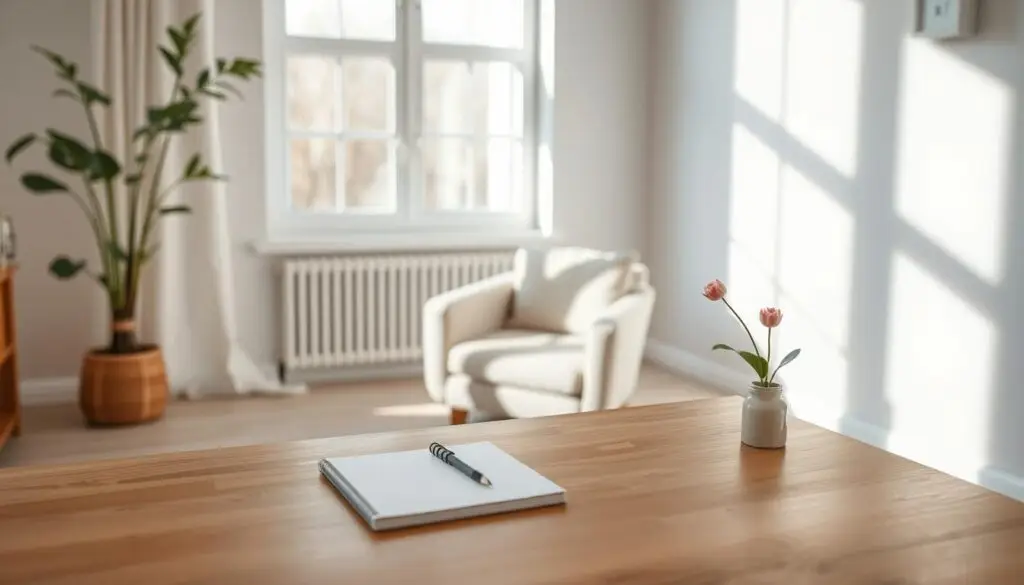
Designing Focus Areas with Intention
Choose three key stages per room—no more. A floating shelf for rotating art, one wall for family photos, a console table for seasonal decor. Keep other surfaces clear to let these moments breathe. See how different approaches compare:
| Focus Area | Purpose | Example Items | Rotation Frequency |
|---|---|---|---|
| Floating Shelf | Showcase evolving collections | Ceramic vases, art books | Seasonally |
| Accent Wall | Display large-scale art | Family portraits, textile hangings | Yearly |
| Console Table | Create entryway moments | Key dishes, fresh flowers | Monthly |
Curating Personal Art and Decor
Mix heirloom pieces with oddball finds—your spaces feel richer when stories collide. That chipped teacup from Lisbon? Pair it with a modern sculpture. Designer Sheft suggests:
“Leave breathing room between treasures. Let each object claim its spotlight.”
Try the 3-step edit: 1) Gather all candidate items 2) Remove duplicates 3) Keep only what makes your heart flutter. Rotate quarterly to keep interiors feeling fresh yet familiar. Your home becomes a living scrapbook—quietly proud, never cluttered.
Practical Steps for a Warm Minimalism Design Home Makeover
Transforming your space doesn’t require magic—just smart strategy. Let’s break it down into achievable phases that honor your daily life while elevating your surroundings.
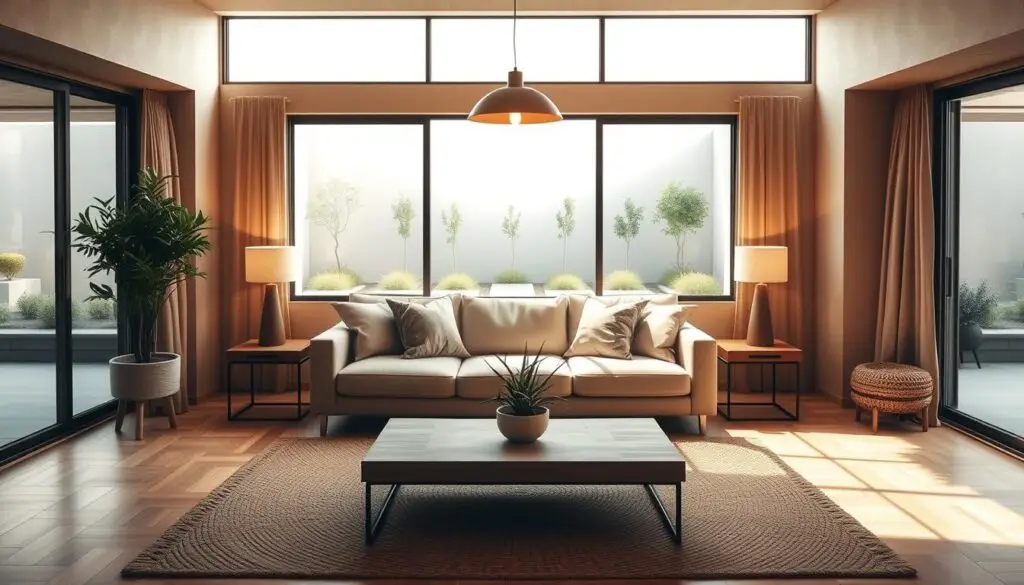
Building Your Foundation
Start by resetting your canvas. Paint walls in oatmeal or greige tones—these act like cozy sweaters for your rooms. Swap hollow-core doors for solid wood versions. If paneling feels daunting, try a single accent wall with vertical oak slats.
When selecting furniture, hunt for pieces that whisper stories. A dining table with visible knots. A linen sofa that softens over time. Prioritize quality over quantity—each item should earn its keep through beauty and function.
Curating with Purpose
Adopt our room-by-room approach:
- Empty shelves and surfaces completely
- Reintroduce items one by one, asking: “Does this spark joy or serve daily needs?”
- Leave 30% of each surface bare
Designer Elena Frampton suggests:
“Edit until you feel relief, not emptiness. That’s your sweet spot.”
Layer textures through homespun details—a handwoven rug underfoot, clay pots on windowsills. Install dimmable LED strips along bookshelves to highlight your favorite objects at night. Remember: patina is your ally. Let that leather chair develop a golden glow over time.
Lighting and Finishing Touches: Enhancing Warmth and Clarity
Ever noticed how light can change a room’s mood completely? We’ve seen spaces transform from stark to stunning with strategic lighting design. It’s not just about brightness—it’s crafting atmosphere through shadows and highlights.
Incorporating Integrated and Hidden Lighting
Start by thinking like a film director. Ambient lighting sets your scene’s base tone—try dimmable ceiling fixtures or recessed LEDs. Task lights become your spotlight: adjustable wall sconces for reading nooks, under-cabinet strips for meal prep areas.
Hidden solutions work magic. LED strips along shelves make your favorite books glow. Wireless systems let you control space temperatures and brightness without clunky switches. We love how concealed fixtures in crown molding create soft ceilings that feel like sunset light.
Choose finishes that whisper quality. Brushed brass switch plates. Matte-black outlet covers. These tiny details keep your interior cohesive while letting the warmth shine through. After all, the best lighting makes rooms feel lived-in, not staged.


